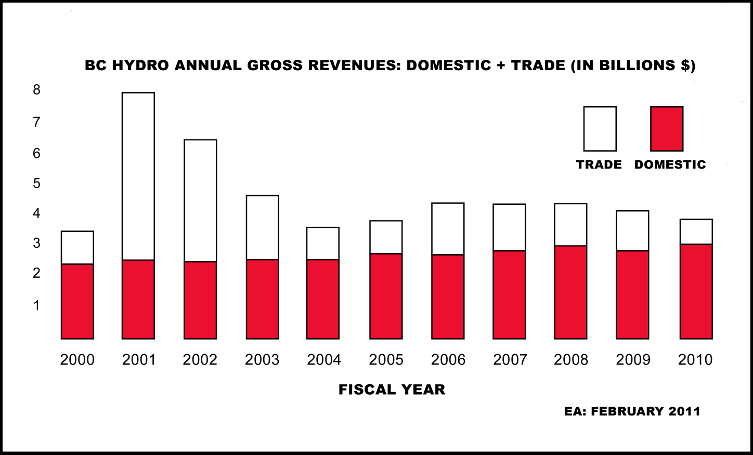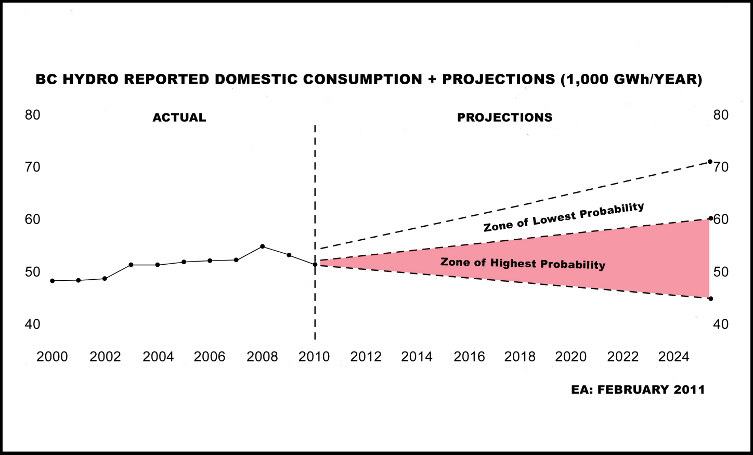Editor’s Note: The Common Sense Canadian presents a second in-depth report from economist Erik Andersen on the troubling trajectory of BC Hydro’s finances. After first exposing Hydro’s increasingly shaky financial position in these pages last year, Mr. Andersen now delves into the numbers to show the inevitable consequences of this situation for the province’s ratepayers: skyrocketing power bills for years to come. On the bright side, we are making real headway in terms of domestic energy conservation – and yet, Hydro continues to commit us to more private power contracts we simply don’t need.
—————————————————————————
January news releases by BC Hydro indicated the intention to alter the “Standing Offer Program” (SOP) by giving new Independent Power Producers (IPPs) higher contract purchase prices for the electricity they generate. “The SOP pricing has been increased between 14 and 29%, depending upon the location of the project.” The SOP is a special private power purchasing program – separate from the “clean power call” tendering process – for “smaller” projects, which are entirely exempted from any public review process or environmental assessment. In addition to raising the purchase price for this power, BC Hydro intends to up the maximum size from 10 to 15 Megawatts.
What follows is a presentation about declining productivity at BC Hydro and why it is folly to be promoting more generation capacity in the circumstances of 2011.
It is instructive to look at the BC Hydro record when making a judgment as to their intention to contract for more IPP generation capacity. BC Hydro presented a ten-year outlook “for new resources” in their 2000 Annual Report. By 2009 the “probable forecast” of demand was to be 65,000 GW hrs. It was not made clear if this included demand from other than BC customers but it should not have as the corporation is only directed to serve the interests of BC customers (“domestic” customers in their language).
The actual energy sale to domestic customers in 2009 was 53,588 GW hrs – and by 2010 it had fallen to just 50,233 GW hrs.
This exaggerated outlook at future demand was in error by 21% (and 29% by 2010). From 2000, when the outlook was presented, there were 9 years of records that should have prompted a major revision of this inflated projection.
What would have been a better way to look at “planning for the future”?
Graphic 1 below shows the annual domestic and trade (export) revenues from each of the past 11 years. Only minor changes in total domestic revenues have occurred. A slight increase in later years is explainable, not by volume of sales increases, but rather by rate increases. By comparison, revenues from sales to others have been very volatile and sharply lower in the most recent years. This record is indicative of a fickle market and one that should be avoided, not one to chase after. Planning for the future is therefore relatively straightforward. The strongest positive correlation is between the province’s population and per capita demand.

Graphic 2 is a demonstration of this relationship. It is divided to indicate the record up to 2010 and a projection to 2025. Because there has been a recorded drop-off in per capita electricity consumption in the past 2 years, it is reasonable to think of this continuing. Per capita consumption will decrease as citizens are forced to make accommodation in their budgets for higher food prices, taxes such as the HST, etc. There will also be substitution in response to higher rates, as is now occurring. Lastly, more people will try to lower consumption using an array of conservation methods such as more insulation, etc.

Graphic 3 is an extrapolation of the per capita consumption rates combined with the official projection for provincial population numbers, expressed in gross electricity demand for the province. As this graphic illustrates, the zone of highest probability indicates
that by 2025 the domestic demand would range between 45,000 and 60,000
GW hrs.

For the reader to appreciate the preceding outlook, it is instructional to look at BC Hydro’s financial record. With most businesses it is usual to expect increasing capital investment will produce improved productivity. The exact opposite has occurred at BC Hydro.
Graphic 4 below is an expression of asset and debt amounts, per GW hr of domestic production and sales, in each of the 11 years. At a glance it is easy to see that for a unit of energy, the needed financial resources remained remarkably constant until 2008 when we see the “Hockey stick” curve develop. In a few short years it suddenly took about 40% more financial resources to produce the same or less GW hrs of energy needed by domestic consumers.

So what does this record indicate?
BC Hydro is using vastly more financial resources to produce and deliver the amount of energy the domestic customers will need into the foreseeable future. This divergence in cost versus demand can only be managed by much higher electricity rates to its captive customers. Seeking greater returns from other than domestic customers is akin to pushing on a rope.
Promulgating a call for more IPP generated energy, at even higher than previous prices, suggests a situational awareness deficit at BC Hydro and is an insult to its customers.
Erik Andersen, Economist
February 13, 2011


Dear Casador (presumably not your real name). Would you please refain from claiming what I and Rafe have to say about BC Hydro and their fellow travelers of which you might possibly one. We will speak for ourselves thank you.
All origonal data is obtained from the audited statements and the official government population statistics. If you have a beef take it up with the auditors.
In case it has escaped your notice I specifically avoid any discussion of energy traded to customers outside of BC. This is deliberate for two reasons. First is that the people of BC are only interested in having BC Hydro produce the electicity they need. Second is the fact it makes zero sense for BC citizens to guarrantee private producers minimum annual incomes that mean the costs to produce for others is twice or more what they are prepared to pay.
Your words are as old as time. By trashing the messenger you hope to trash the message.
Dear Sid; Your recomendation to phone people at Hydro is laughable. After years of suffering with folks saying one thing one time and something diferent the next time I have leaned to only rely upon the writen record.
If what is presented in these Hydro articles by me is factually wrong then someone is at liberty to publicly correct the record because I choose not to hide behind a made up name.
Interesting back and forth folks.
Let us all be clear about what are the facts. Trying to have a discussion of motives, for example, is a waste of time. All materlial presented in this article is data taken from the Audited statements of BC Hydro. There is nothing from other parts of the Annual Reports save the GWhs sold to domestic customers.
Since all IPP contracts are explictly secret, confirmed by BCUC letter directly to me, speculation about those producers and their rates is just that, speculation.
What the data shows is a clear indication that energy needs of BC customers are diminishing on a per capita basis. Combine that demonstrated trend with the official BC population projections and it is unquestionably clear that the BC domestic need are unchaging by almost nothing into the next 15 years.
I have had folks try to tell me that the massie increase in borrowing and spending is because the whole system was run into the ground by previous managers. In the case of one such person, an insider. I asked him to put that critic of the previous admisinstrations on the public record and he ran away. I surmissed it was because that was not true.
Damien, thanks for adding to the quality of this discussion with your ad hominem attacks. Hint on import/export issue: check and see if Stats Canada and the NEB could interprovincial movements in their calculations.
As to the BCUC and the 2009 CPC, you will have to be a bit more specific on your complaint.
Cassador, based on your comments you must be either: A) a Liberal party hack; B) a private power hack; or C) completely clueless…or perhaps all of the above. Bill 30 deprived the citizens of this province of any real consultation (not “comment”, but consultation) on private power projects – a complete subversion of our democratic process. You also don’t appear to have received the memo that our once independent public regulator, the BCUC, has also been neutered by this government – overruled on their objection in 2009 to the latest “clean power call” (an Orwellian term if there ever was one), and deprived of any oversight over Site C. The truth is, General Electric, Ledcor, Accenture, and Alcan have been put squarely in charge of our energy policy and our wild rivers. If you want to talk net importer vs. net exporter, you’ll find that taking into account the overall numbers for the province (as opposed to BC Hydro alone), we are even more consistently net EXPORTERS of electricity – according to Stats Canada and the National Energy Board…The bottom line is we’re being committed to buying expensive private power that we don’t need, as Mr. Andersen’s report clearly demonstrates.
Sid, BC Hydro did in fact recommend against the last Campbell private power purchase call – asking for it to be reduced from 5,000 GW to 3,000. They were overruled, as was the BC Utilities Commission who also objected to the rationale for buying more of this power, finding that it was not in the public interest. Hydro is under considerable duress and even if they wanted to give us the straight goods, they can’t. Just ask former CEO Bob Elton why he was fired last year. I’ll take Mr. Andersen’s independent analysis of the numbers any day of the week over what BC Hydro, the Campbell government, or the private power racket tell us.
I really have to wonder if Mr. Anderson has bothered to talk to anyone at BC Hydro to see if there are other explanations for what he claims to be seeing in his tea leaves? Mr. Anderson seems to be taking the Inspector Clousseau approach to solving the puzzle. Maybe a quick phone call might solve the case more quickly. But that would take all the fun out of it now, wouldn’t it?
Dear Laurie. I note you say I am “wrong” but fail to say where. OK….. Your comment on Campbell’s bill so munis could not veto energy projects is the same system in every province in Canada to my knowledge – energy projects are the exclusive purview of the energy regulator, in our case the BCUC, NOT munis. Munis can input, protest, sue, etc but no longer can deny energy projects because they do not understand the facts or are not happy with the tax take. Funny your comment about aboriginals – I attended a meeting late last year in Chilliwack (required by the BC government for IPPer to introduce his project) where an IPPer presented his project – a partnership with aboriginals – and the Chief told the ENGOs to get lost (my turn of phrase) – stop interfering with our development. Didn’t make Gwen Barlee too happy!
Dan: BC Hydro agrees it is importing, Ministry of Energy ditto. Do not confuse BC and “BC Hydro”. Note some agencies ignore domestic flows, and some treat the Columbia River entitlement differently. Do your homework and I think you will find we are importing and have been for years. YES, much of the imports are dirty power; hence the drive to cease imports.
Casador, you know that you’re wrong and this issue is not even a matter for debate. It is about Gordon Campbell enriching his friends by raping the pristine environment to create power at a time we don’t need it and at rates we can’t afford.
When the residents near one of the first IPP’s refused to allow the project, Campbell changed the law to dis-empower municipalities. When he tried to put another one in the Pitt River watershed the people rose up to stop it.
The sad thing is that in the hundreds of other more remote places where Campbell’s friends want to (or have already) put IPP’s, there aren’t enough people to protest.
I feel very sorry for our Aboriginal neighbors whose traditional territories are being devastated by the construction of transmission-line roads and the desecration of salmon-bearing streams and rivers that have fed their families for centuries.
Gordon Campbell is the biggest bully this province has ever seen – thank goodness he’s almost gone.
I hope you’ll soon realize that this economist isn’t talking in a partisan manner – he’s presenting us the info we need to be informed about one of the most critical issues we have ever faced in British Columbia.
Well Casador,
You can call this cherry pie if you like; where are your facts in rebuttals? It is fine to trash someone on the internet with your “opinion.”
Here are two facts you cannot claim as a lie.
#1. British Columbia is NOT a net importer of energy for its own use; one only has to look at the last ten years of BC Hydro records.
#2.The electricity BC imports is cheap dirty power from Alberta and California will never purchase it for their use.
When you have something worth reading let us know.
Mr. Anderson is either untruthful or ignorant of the facts. NO IPP can be built, regardless of size, without an environmental assessment process – it is just a different process for the small ones, but basically the same permits and licences. And the stunning realization that power from new power plants, be they built by BC hydro or the private sector, costs more than plants built decades ago, is probably not going to win him a prize. In the only two test cases I know of (Abefeldie and Duke Point), BC Hydro’s costs were higher than the IPPs.
I do not mind a good debate. I do object to Rafe Mair and this guy feeding absolutely false information to the public. I have been charitable; otherwise I would call his statement about no environmental or public process a flat out lie.